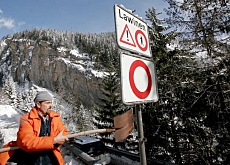125 years of eyes on the skies

Switzerland's weather service, MeteoSwiss, which has come to play a vital role in everyday life, is celebrating its 125th anniversary this year.
After first struggling to win acceptance, MeteoSwiss has gone from strength to strength. More recently its focus has turned to safety and coping with a rise in extreme weather conditions.
“We should never forget that nature behaves in a fundamentally chaotic way. Maybe weather forecasts will never be completely accurate,” says Peter Binder, head of research at MeteoSwiss.
However, in recent decades the service has made enormous strides. Today 85 per cent of Swiss weather forecasts are accurate.
The days are long gone when weather forecasters were the butt of jokes and their predictions were rated alongside those of astrologers and charlatans.
There was some resistance when the Swiss government decided to set up the national Central Meteorological Institute, as MeteoSwiss was then known, in 1881.
Some researchers doubted the scientific value of daily forecasts, but the government, convinced that they could be of use to the population, especially farmers, went ahead with its plan.
Officials also hoped that the forecasts would help combat some of the widespread weather superstitions.
Nevertheless, early newspaper weather reports were generally accompanied by a text explaining that bulletins “should not be considered as prophecies, but rather as well-founded assumptions”.
Leap forward
A great leap forward was made in the 1920s, when an aviation weather service was created to meet the demands of the growing aviation industry.
Technological developments, such as satellites, computers and radar, have since made a great difference to meteorology.
Nowadays, most sectors of the economy, including aviation, construction, agriculture, and the hotel and catering trades, rely on accurate weather forecasting.
The public also follows the bulletins with interest, especially for their leisure time, as tourism and some sports are very dependent on the weather.
Over the last few decades, MeteoSwiss has therefore developed an extensive range of specialised services for both the public and private organisations, including wind measurement for airlines, climate studies for insurance companies, and information about the pollen count.
Meteorology has also played an increasing role in the prevention of natural disasters, as both the authorities and the public are provided with severe weather warnings (storms, heavy rainfall or snowfall and thunderstorms).
Climate change
However, scientists fear that that rapid climate change could cause more extreme weather conditions in the future.
Experts say that Switzerland, with its Alpine terrain, could suffer serious consequences, such as floods, landslides and avalanches.
Periods of exceptional cold or heat may have dramatic repercussions on the population’s health, particularly among the elderly.
This has led to some concern among the population and the authorities.
“People have become quite sensitive to climatic issues. Every time we have exceptional temperatures or rainfall, we are asked if this is evidence of [climate] change caused by human activity,” says Binder.
“But it is nevertheless true that global warming is a matter of serious concern. The increase in greenhouse gases and the changing chemical composition of the atmosphere are bound to affect our climate.”
Added to this is the fact that despite improvements in technology, Switzerland, with its complex relief, is not always a breeze for weather forecasters.
“We are dealing with a territory which is extremely irregular in terms of its geography and its mountains and this has unpredictable effects on rainfall, cloud cover and fog at high altitudes,” explains Binder.
“Achieving more that 85 per cent accuracy is therefore a very difficult and expensive undertaking.”
swissinfo
MeteoSwiss, part of the Interior Ministry, provides the population, public bodies and businesses with meteorological and climate information.
It employs around 270 people. 800 non-professional observers man its recording stations.
Half of its budget is allocated by the federal authorities. The remainder comes from payments for the services it provides.
Meteorological data has been gathered in Switzerland since 1863, when 88 weather stations were set up by the Swiss Society of Natural Science.
1881: the government decided to establish the Central Meteorological Institute, now MeteoSwiss.
1927: to meet the needs of the growing aviation industry, an aeronautical meteorological service was established.
1936: an early warning service for storms was introduced for the Alpine region and for the Swiss lakes.
1951: a meteorology service for agriculture was set up.
1993: MeteoSwiss began providing daily pollen count information.

In compliance with the JTI standards
More: SWI swissinfo.ch certified by the Journalism Trust Initiative












You can find an overview of ongoing debates with our journalists here . Please join us!
If you want to start a conversation about a topic raised in this article or want to report factual errors, email us at english@swissinfo.ch.